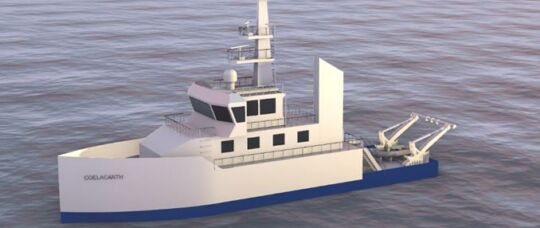Designers: Victoria Kim, Alexander Lytle, Lorenzo Pensabene, Natalie Webb
Vessel Type: Oceanographic Research Vessel
Vessel Mission:
The research vessel is intended to meet the demand for small and efficiently crewed research vessels that are suitable for coastal and near-shore research projects. Its purpose is to provide a platform to support a wide range of general marine and ocean sciences that is cost efficient and environmentally friendly.
Features:
• Hybrid battery/deisel electric.
• A-frame crane and J-frame crane for in water instruments and remotely operated equipment.
• Capability to carry, deploy, and maintain:
• One 15-foot high-speed RHIB.
• Six medium-sized AUVs.
• Four small ASVs.
• Over 400 square feet of lab space.
• Accomodates 12 scientists and 5 crew.
• Uncontaminated seawater system.
• Flying bride observation station with two big eye binocular mounts.
• Two oceanographic winches.
• Axe bow
• Dual 660 kW azimuthing L-drives
View Presentation
Visit our Junior Class Small Vessel Design Project page to view all of this year’s projects.
About Junior Class Small Vessel Design Project (SD1):
As a part of Professor Bradley D.M. Golden’s ’99 Ship Design 1 (SD1) class, the juniors spent the first two-and-a-half months of the spring semester preparing their first complete concept designs.
Using the knowledge they’ve gained in their nearly three years studying at Webb and the experiences from their winter work periods to date, this was the students’ first opportunity to apply the naval architecture and marine engineering principles they’ve studied including stability, ship’s structures, main machinery systems, auxiliary systems, resistance and propulsion, and electrical engineering.
Working in small groups of three and four, the students selected one of the vessel types and took their first couple of spins around the design spiral to prepare vessel concept designs. To help make the project as realistic as possible, members of industry familiar with each of the vessel types helped prepare the statements of design requirements that each of the designs had to meet. To challenge the students even further, one or two “curveballs” were thrown into each design statement to make the students think long and hard about how they would achieve their objectives.
At the end of the spring semester, the students presented their final designs to their fellow students, faculty, and members of industry who served as part of an evaluation team. After three years at Webb, the Junior class can now say with confidence that they’re familiar with the design process and are well on their way to joining the fields of naval architecture and marine engineering.

